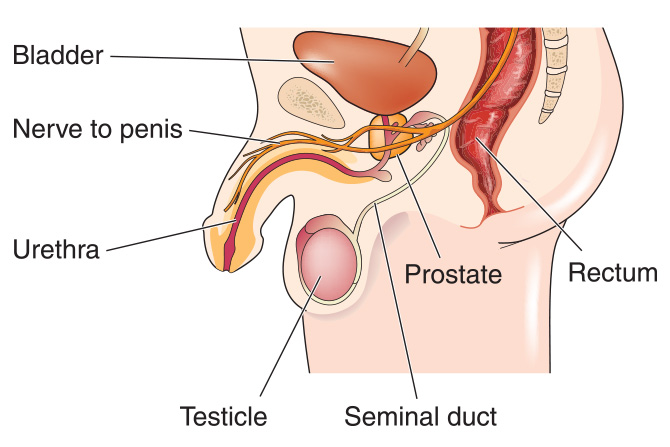Overview [1]
Symptoms [2]
Causes [3]
Prescription [4]
Health Tips [5]
The prostate is a small, chestnut-sized gland located just below the bladder in men. It is wrapped around the urethra, the pathway for seminal fluid and urine. Prostatitis is a group of various conditions that affect the prostate, potentially causing painful symptoms, infection or inflammation. There are four types of prostatitis.
Chronic nonbacterial prostatitis (CP): Also referred to as chronic pelvic pain syndrome (CPPS). This form is the most common type and the most difficult to treat. It accounts for approximately 90 percent of prostatitis cases. There may or may not be inflammation of the prostate.
Acute bacterial prostatitis (ABP): Caused by a bacterial infection of the prostate. A severe urinary tract infection may also be present. It is easy to diagnose but can be very serious if left untreated. It is the least common of the four types.
Chronic bacterial prostatitis (CBP): Much like acute bacterial prostatitis but with reoccurring infection that lasts longer. Symptoms are milder than with the acute form. It is only slightly more common than ABP. Men with benign prostatic hyperplasia (BPH) are more likely to suffer this form of prostatitis.
Asymptomatic prostatitis (AP): With this form white blood cells can be detected, and in addition there may be inflammation of the prostate. Other than the increased white blood cells, there are no symptoms. It is usually discovered when testing for other conditions such as infertility.
Symptoms
Symptoms of prostatitis vary depending on the type. Some possible symptoms are:
Chronic nonbacterial prostatitis:
- Discharge from the penis
- Loss of sex drive
- Pain in genitals or rectum
- Pain in the lower abdomen and back
- Weak urine flow
Acute bacterial prostatitis:
- Blood in semen and urine
- Difficulty emptying bladder
- Fever and chills
- Frequent urge to urinate
- Pain in genitals or rectum
- Pain in the lower abdomen and back
- Painful bowel movements
- Painful urination or ejaculation
- Urinary tract infection
- Weak urine flow
Chronic bacterial prostatitis:
- Does not respond to first treatment attempt
- Reoccurs after treatment
- Same as ABP symptoms above, but less severe
Asymptomatic prostatitis:
- High white blood cell count
- Inflammation of the prostate
- No other symptoms
Causes
ABP and CBP occur when bacteria from a urinary tract infection (UTI) or sexually transmitted infection (STI) such as chlamydia makes its way to the prostate via blood or urine.
Other potential causes are:
- A blockage of the bladder of urethra due to an enlarged prostate (BPH) [6] or bladder stones
- Inflammation in the tube that connects the vas deferens and the scrotum, known as the epididymis
- The use of a catheter
- Trauma or injury to the space between the rectum and scrotum (perineum)
Risk factors that can contribute to bacterial prostatitis are:
- Unprotected sex
- Dehydration
- Genetic factors
- Pelvic injuries due to bike and horseback riding
- Stress
- HIV
The cause of CP/CPPS is hard to pinpoint because there are likely multiple factors that may never be identified. Some possible factors include chronic stress, inflammation, lack of ejaculation, hidden fungal or viral infection, physical trauma to the pelvis, riding long distances on a bicycle or motorbike, autoimmune disorders, surgery, poor diet, excess alcohol, food allergies, and swimming in polluted water.
Prescription for Health
| Nutrient | Dosage | Action |
|---|---|---|
| Rye grass pollen extract (cernilton or graminex) | 500 mg daily | 70 percent reduction in nocturnal urination, significantly improves urine flow rate |
| Pygeum africanum standardized to contain triterpenes, sterols, and n-docosanol | 50 mg twice daily | Alleviates symptoms |
| Quercitin | 500 mg twice daily | Clears symptoms of prostatitis |
| Moducare sterols and sterolins | One capsule three times daily | German research has shown it effective in reducing symptoms of BPH, and halting the conversion of testosterone to DHT |
| Zinc | 30–60 mg | Reduces prostate size and symptoms, inhibits conversion of testosterone to DHT |
| Whey protein powder | One to two scoops daily | High-protein diets inhibit 5-alpha-reductase, which converts testosterone to DHT |
| Lycopene | Two capsules daily | Reduces risk of prostate disease |
| Lactobacillus acidophilus | 1 tsp (5 mL) containing 1–2 billion active organisms daily | Improves intestinal flora to reduce harmful bacteria; required if antibiotics are being taken for prostatitis |
| Stinging nettle extract | 300 mg daily | Suppresses prostate membrane activity, which may in turn lower inflammation and tissue enlargement and inhibit prostate cell growth |
Health Tips for Healing
- Address urinary tract infections [7].
- Develop healthy lifestyle habits, get enough sleep, exercise 30 minutes a day; see Adrenal Fatigue [8] to see how to reduce stress.
- Increase anti-inflammatory foods such as vegetables, fruits, whole grains, quality fats and omega-3s, quality proteins (beans, organic chicken and eggs, salmon, sardines).
- Practice safe sex.
- Reduce alcohol and caffeine intake; both irritate the bladder and dehydrate the body.
- Reduce pro-inflammatory foods from the diet such as deep-fried foods, processed foods, refined grains, red meat, sugar and soda pop.
- Reduce riding bikes and horseback riding if experiencing symptoms.
